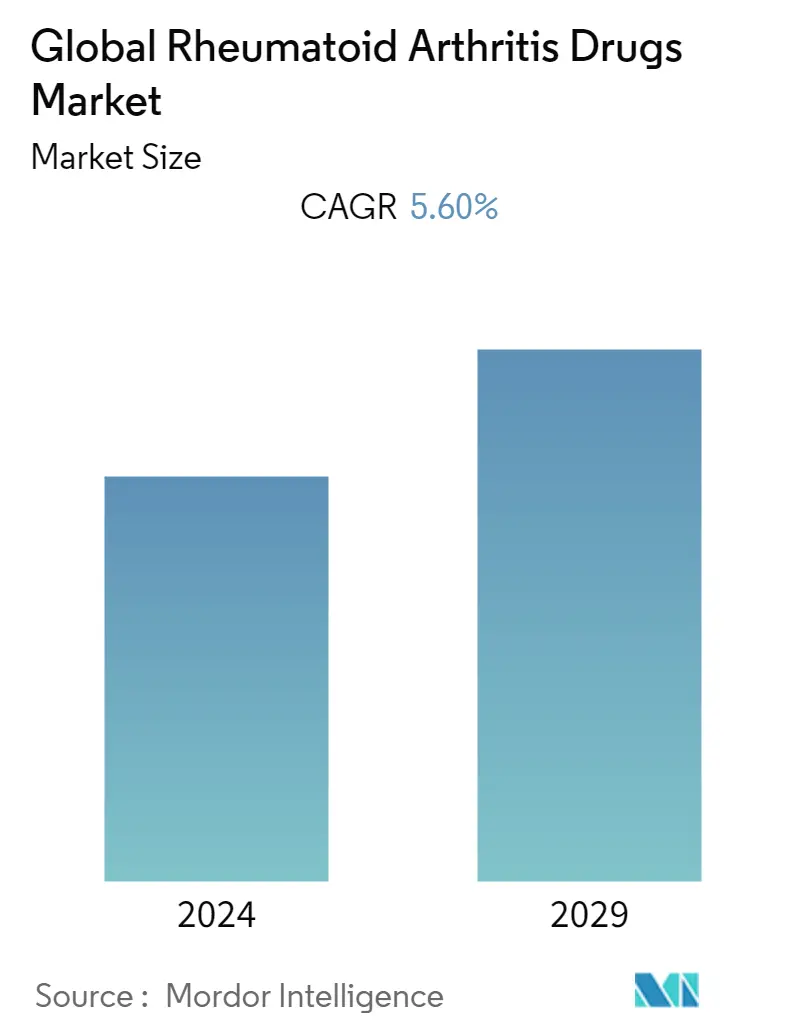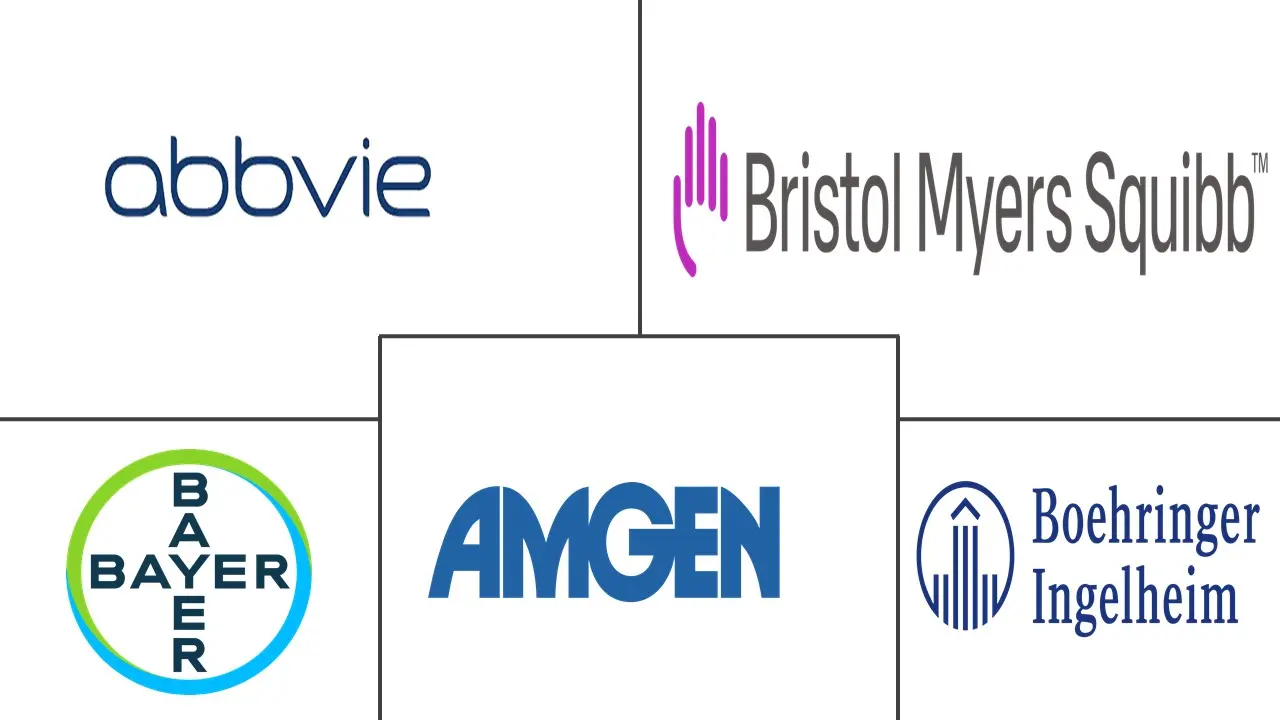Market Size of Global Rheumatoid Arthritis Drugs Industry

| Study Period | 2019 - 2029 |
| Base Year For Estimation | 2023 |
| Forecast Data Period | 2024 - 2029 |
| CAGR | 5.60 % |
| Fastest Growing Market | Asia Pacific |
| Largest Market | North America |
Major Players
*Disclaimer: Major Players sorted in no particular order |
Rheumatoid Arthritis Drugs Market Analysis
The rheumatoid arthritis drugs market is poised to grow at a CAGR of 5.6% during the forecast period (2022-2027).
COVID-19 had a significant impact on the rheumatoid arthritis drugs market as rheumatoid arthritis (RA) patients had a higher risk of COVID-19 infection. For instance, according to the study titled "Risk of COVID-19 in Rheumatoid Arthritis: A National Veterans Affairs Matched Cohort Study in At-Risk Individuals" published in October 2021, patients with rheumatoid arthritis (RA) were more likely to develop COVID-19 and severe COVID-19 (which can lead to hospitalization or death) than those without RA. In addition, the study titled "The COVID-19 pandemic: an increased risk of rheumatoid arthritis" published in June 2021, reported that because of the iatrogenic consequences of RA-related pharmacological therapy, patients predisposed to RA have a greater infection risk than the general population. As a result, a COVID-19 pandemic might increase the probability of a health emergency in complicated conditions such as RA. Thus, owing to such instances, COVID-19 infection had a pronounced impact on the rheumatoid arthritis drugs market over the forecast period.
The key factors propelling the growth of the rheumatoid arthritis drugs market are the launch of new biosimilars, the rising prevalence of arthritis worldwide, and an increase in the acceptance of biopharmaceuticals.
According to the study published in Rheumatology International, titled "The global prevalence of rheumatoid arthritis (RA): a meta-analysis based on a systematic review" in November 2020, the global prevalence of RA was estimated to be 0.46 percent. This will lead to increased adoption of therapies for RA treatment and thus drive the market's growth.
Additionally, rising product launches by the market players are expected to boost the market's growth. For instance, in September 2020, Lupin launched generic leflunomide in the United States to treat adults with active rheumatoid arthritis. This will lead to increased adoption of rheumatoid therapies in patients, driving the market growth. Moreover, rising approvals of biosimilars for treating rheumatoid arthritis also contribute to market growth. For instance, in October 2021, the United States Food and Drug Administration approved Cyltezo. It is one of the first interchangeable biosimilars to Humira to treat rheumatoid arthritis.
Thus, owing to the abovementioned factors, the market is expected to show growth over the forecast period. However, alternative treatment options and patent expiration of branded drugs may hinder the market's growth during the forecast period.
Rheumatoid Arthritis Drugs Industry Segmentation
As per the scope of the report, rheumatoid arthritis is an autoimmune disorder that causes pain and inflammation in the body's joints. Rheumatoid arthritis disease primarily affects the joints of the hands, wrists, elbows, knees, and ankles. It also affects the cardiac and respiratory systems and is a systemic disease. It thus exhibits symptoms of swelling, redness, and warmth in the affected areas. The Rheumatoid Arthritis Drugs Market is segmented by Type of Molecule (Pharmaceuticals and Biopharmaceuticals), Drug Class (Non-steroidal Anti-inflammatory Drugs (NSAIDs), Corticosteroids, Analgesics, Other Drug Classes), Sales Channel (Prescription, Over-the-counter (OTC)), and Geography (North America, Europe, Asia-Pacific, Middle East, and Africa, and South America). The report also covers the estimated market sizes and trends for 17 countries across significant global regions. The report offers the value (USD million) for the above segments.
| By Type of Molecule | |
| Pharmaceuticals | |
| Biopharmaceuticals |
| By Drug Class | |
| Non-steroidal Anti-inflammatory Drugs (NSAIDs) | |
| Corticosteroids | |
| Analgesics | |
| Other Drug Classes |
| By Sales Channel | |
| Prescription | |
| Over-the-counter (OTC) |
| Geography | ||||||||
| ||||||||
| ||||||||
| ||||||||
| ||||||||
|
Global Rheumatoid Arthritis Drugs Market Size Summary
The rheumatoid arthritis drugs market is experiencing a steady growth trajectory, driven by several key factors. The introduction of new biosimilars and the increasing prevalence of arthritis globally are significant contributors to this expansion. The market is also benefiting from a growing acceptance of biopharmaceuticals, which are becoming more prevalent in treatment regimens. The COVID-19 pandemic had a notable impact on the market, as patients with rheumatoid arthritis faced higher risks of severe COVID-19 infections, influencing the demand for effective treatments. Despite challenges such as alternative treatment options and the patent expiration of branded drugs, the market is expected to continue its growth over the forecast period.
The NSAIDs segment is anticipated to maintain a substantial share in the market, supported by their widespread use for symptomatic relief in rheumatic disorders. The increasing global prevalence of rheumatoid arthritis is boosting the demand for NSAIDs, with new product launches further propelling segment growth. North America is projected to hold a significant market share, driven by the high prevalence of the disease, the presence of key market players, and ongoing investments in novel therapies and biosimilars. The competitive landscape is characterized by the dominance of major players like AbbVie Inc., Amgen Inc., and others, while emerging markets in the Asia-Pacific region are seeing the entry of smaller players, contributing to the market's dynamic nature.
Global Rheumatoid Arthritis Drugs Market Size - Table of Contents
-
1. MARKET DYNAMICS
-
1.1 Market Overview
-
1.2 Market Drivers
-
1.2.1 Growing Preference Towards Development of Biologics and Biosimilars
-
1.2.2 Rising Burden of Arthritis
-
-
1.3 Market Restraints
-
1.3.1 Patent Expiration of Blockbuster Drugs
-
1.3.2 Alternative Treatment Options
-
-
1.4 Porter's Five Forces Analysis
-
1.4.1 Threat of New Entrants
-
1.4.2 Bargaining Power of Buyers/Consumers
-
1.4.3 Bargaining Power of Suppliers
-
1.4.4 Threat of Substitute Products
-
1.4.5 Intensity of Competitive Rivalry
-
-
-
2. MARKET SEGMENTATION (Market Size by Value - USD million)
-
2.1 By Type of Molecule
-
2.1.1 Pharmaceuticals
-
2.1.2 Biopharmaceuticals
-
-
2.2 By Drug Class
-
2.2.1 Non-steroidal Anti-inflammatory Drugs (NSAIDs)
-
2.2.2 Corticosteroids
-
2.2.3 Analgesics
-
2.2.4 Other Drug Classes
-
-
2.3 By Sales Channel
-
2.3.1 Prescription
-
2.3.2 Over-the-counter (OTC)
-
-
2.4 Geography
-
2.4.1 North America
-
2.4.1.1 United States
-
2.4.1.2 Canada
-
2.4.1.3 Mexico
-
-
2.4.2 Europe
-
2.4.2.1 Germany
-
2.4.2.2 United Kingdom
-
2.4.2.3 France
-
2.4.2.4 Italy
-
2.4.2.5 Spain
-
2.4.2.6 Rest of Europe
-
-
2.4.3 Asia-Pacific
-
2.4.3.1 China
-
2.4.3.2 Japan
-
2.4.3.3 India
-
2.4.3.4 Australia
-
2.4.3.5 South Korea
-
2.4.3.6 Rest of Asia-Pacific
-
-
2.4.4 Middle-East & Africa
-
2.4.4.1 GCC
-
2.4.4.2 South Africa
-
2.4.4.3 Rest of Middle-East and Africa
-
-
2.4.5 South America
-
2.4.5.1 Brazil
-
2.4.5.2 Argentina
-
2.4.5.3 Rest of South America
-
-
-
Global Rheumatoid Arthritis Drugs Market Size FAQs
What is the current Global Rheumatoid Arthritis Drugs Market size?
The Global Rheumatoid Arthritis Drugs Market is projected to register a CAGR of 5.60% during the forecast period (2024-2029)
Who are the key players in Global Rheumatoid Arthritis Drugs Market?
AbbVie Inc., Amgen Inc., Bayer AG, Boehringer Ingelheim GmbH and Bristol-Myers Squibb Company are the major companies operating in the Global Rheumatoid Arthritis Drugs Market.

